《翻译工作坊》PPT课件
- 格式:ppt
- 大小:200.00 KB
- 文档页数:15
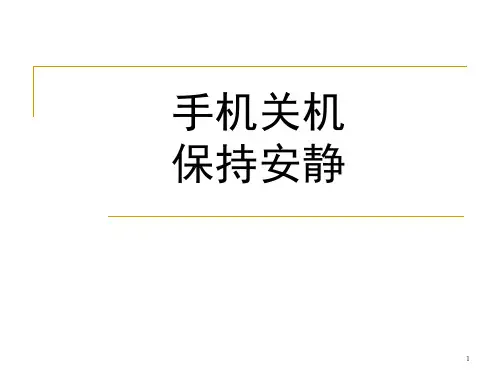
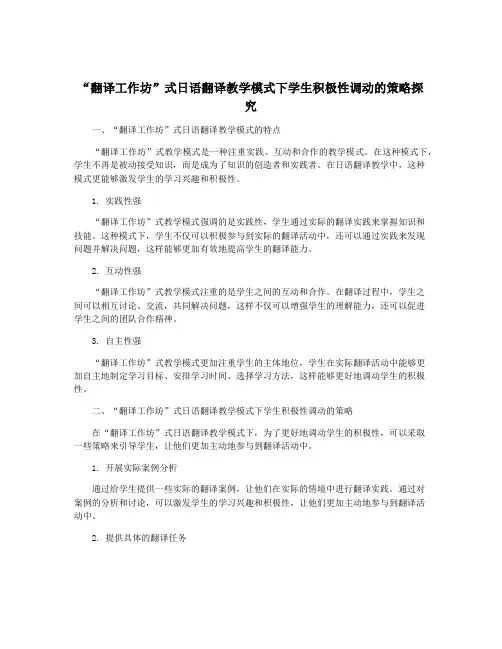
“翻译工作坊”式日语翻译教学模式下学生积极性调动的策略探究一、“翻译工作坊”式日语翻译教学模式的特点“翻译工作坊”式教学模式是一种注重实践、互动和合作的教学模式。
在这种模式下,学生不再是被动接受知识,而是成为了知识的创造者和实践者。
在日语翻译教学中,这种模式更能够激发学生的学习兴趣和积极性。
1. 实践性强“翻译工作坊”式教学模式强调的是实践性,学生通过实际的翻译实践来掌握知识和技能。
这种模式下,学生不仅可以积极参与到实际的翻译活动中,还可以通过实践来发现问题并解决问题,这样能够更加有效地提高学生的翻译能力。
2. 互动性强“翻译工作坊”式教学模式注重的是学生之间的互动和合作。
在翻译过程中,学生之间可以相互讨论、交流,共同解决问题,这样不仅可以增强学生的理解能力,还可以促进学生之间的团队合作精神。
3. 自主性强“翻译工作坊”式教学模式更加注重学生的主体地位,学生在实际翻译活动中能够更加自主地制定学习目标、安排学习时间、选择学习方法,这样能够更好地调动学生的积极性。
二、“翻译工作坊”式日语翻译教学模式下学生积极性调动的策略在“翻译工作坊”式日语翻译教学模式下,为了更好地调动学生的积极性,可以采取一些策略来引导学生,让他们更加主动地参与到翻译活动中。
1. 开展实际案例分析通过给学生提供一些实际的翻译案例,让他们在实际的情境中进行翻译实践。
通过对案例的分析和讨论,可以激发学生的学习兴趣和积极性,让他们更加主动地参与到翻译活动中。
2. 提供具体的翻译任务在“翻译工作坊”式教学模式下,可以通过给学生提供具体的翻译任务来引导学生积极参与。
这些翻译任务可以是一些实际的文本,比如新闻报道、商务文件等,让学生在实际的翻译任务中不断提高自己的翻译能力。
3. 引导学生进行合作翻译在“翻译工作坊”式教学模式下,可以通过组织学生进行合作翻译来调动学生的积极性。
让学生以小组的形式共同完成翻译任务,将会更加激发学生的学习兴趣和积极性。
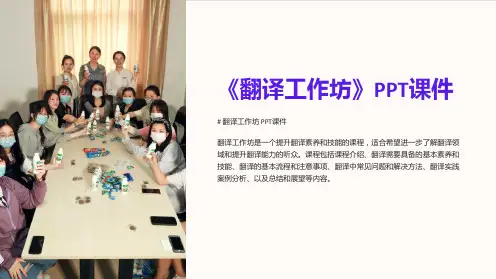
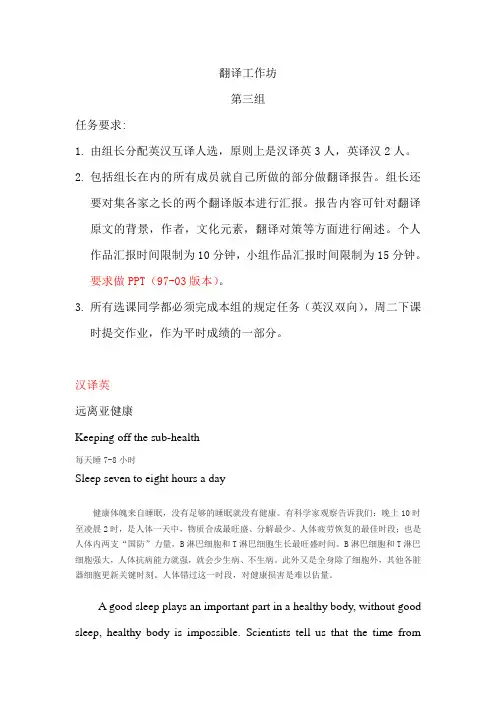
翻译工作坊第三组任务要求:1.由组长分配英汉互译人选,原则上是汉译英3人,英译汉2人。
2.包括组长在内的所有成员就自己所做的部分做翻译报告。
组长还要对集各家之长的两个翻译版本进行汇报。
报告内容可针对翻译原文的背景,作者,文化元素,翻译对策等方面进行阐述。
个人作品汇报时间限制为10分钟,小组作品汇报时间限制为15分钟。
要求做PPT(97-03版本)。
3.所有选课同学都必须完成本组的规定任务(英汉双向),周二下课时提交作业,作为平时成绩的一部分。
汉译英远离亚健康Keeping off the sub-health每天睡7-8小时Sleep seven to eight hours a day健康体魄来自睡眠,没有足够的睡眠就没有健康。
有科学家观察告诉我们:晚上10时至凌晨2时,是人体一天中,物质合成最旺盛、分解最少、人体疲劳恢复的最佳时段;也是人体内两支“国防”力量,B淋巴细胞和T淋巴细胞生长最旺盛时间。
B淋巴细胞和T淋巴细胞强大,人体抗病能力就强,就会少生病、不生病。
此外又是全身除了细胞外,其他各脏器细胞更新关键时刻。
人体错过这一时段,对健康损害是难以估量。
A good sleep plays an important part in a healthy body, without good sleep, healthy body is impossible. Scientists tell us that the time from10:00 pm to 02:00 am is the important time for our body. During this period of time, more substances are synthesized, less disassembled and also the golden time to recover from tiredness. What’s more, this period of time is also the exuberant time for the B lymphocyte and the T lymphocyte, which are the two important “Defense Forces” of our body, to grow. The stronger B lymphocyte and the T lymphocyte are, the more aggressive immunity system is. So that, we have little chance to get ill or never get ill. Besides all the cells of our body, this period of time is also the critical time for the renewal of the cells of other organs. Once this period of time is missed, the damage brought to our body is hard to measure.不忘吃早饭Never forget to have breakfast早饭犹如进补。
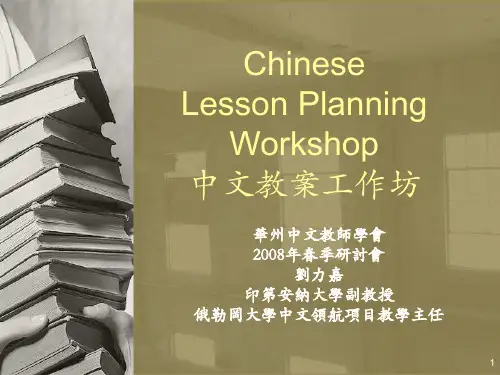
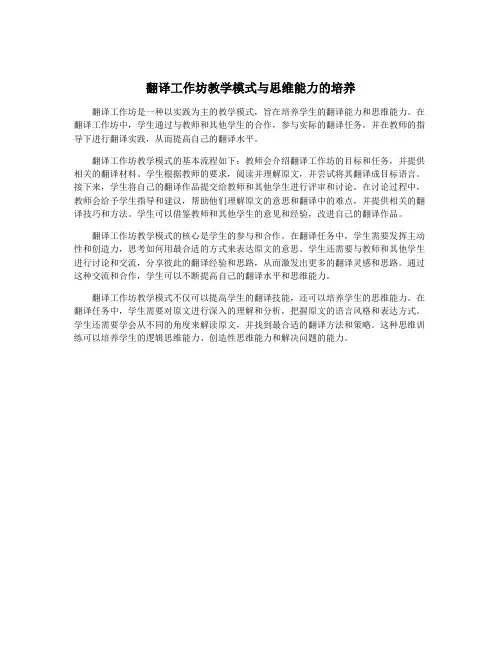
翻译工作坊教学模式与思维能力的培养
翻译工作坊是一种以实践为主的教学模式,旨在培养学生的翻译能力和思维能力。
在翻译工作坊中,学生通过与教师和其他学生的合作,参与实际的翻译任务,并在教师的指导下进行翻译实践,从而提高自己的翻译水平。
翻译工作坊教学模式的基本流程如下:教师会介绍翻译工作坊的目标和任务,并提供相关的翻译材料。
学生根据教师的要求,阅读并理解原文,并尝试将其翻译成目标语言。
接下来,学生将自己的翻译作品提交给教师和其他学生进行评审和讨论。
在讨论过程中,教师会给予学生指导和建议,帮助他们理解原文的意思和翻译中的难点,并提供相关的翻译技巧和方法。
学生可以借鉴教师和其他学生的意见和经验,改进自己的翻译作品。
翻译工作坊教学模式的核心是学生的参与和合作。
在翻译任务中,学生需要发挥主动性和创造力,思考如何用最合适的方式来表达原文的意思。
学生还需要与教师和其他学生进行讨论和交流,分享彼此的翻译经验和思路,从而激发出更多的翻译灵感和思路。
通过这种交流和合作,学生可以不断提高自己的翻译水平和思维能力。
翻译工作坊教学模式不仅可以提高学生的翻译技能,还可以培养学生的思维能力。
在翻译任务中,学生需要对原文进行深入的理解和分析,把握原文的语言风格和表达方式。
学生还需要学会从不同的角度来解读原文,并找到最合适的翻译方法和策略。
这种思维训练可以培养学生的逻辑思维能力、创造性思维能力和解决问题的能力。
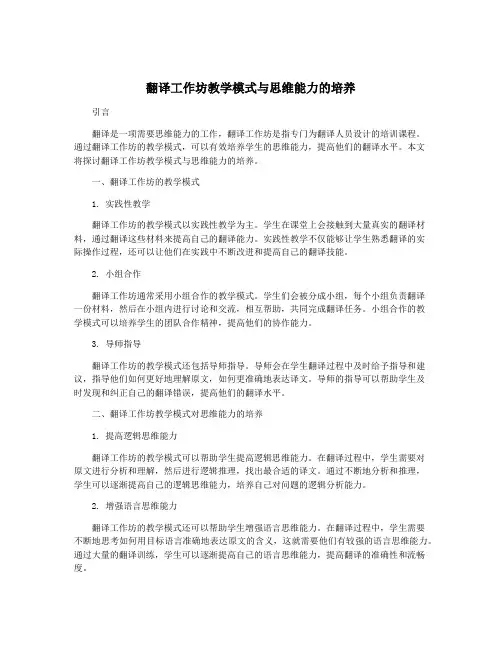
翻译工作坊教学模式与思维能力的培养引言翻译是一项需要思维能力的工作,翻译工作坊是指专门为翻译人员设计的培训课程。
通过翻译工作坊的教学模式,可以有效培养学生的思维能力,提高他们的翻译水平。
本文将探讨翻译工作坊教学模式与思维能力的培养。
一、翻译工作坊的教学模式1. 实践性教学翻译工作坊的教学模式以实践性教学为主。
学生在课堂上会接触到大量真实的翻译材料,通过翻译这些材料来提高自己的翻译能力。
实践性教学不仅能够让学生熟悉翻译的实际操作过程,还可以让他们在实践中不断改进和提高自己的翻译技能。
2. 小组合作翻译工作坊通常采用小组合作的教学模式。
学生们会被分成小组,每个小组负责翻译一份材料,然后在小组内进行讨论和交流,相互帮助,共同完成翻译任务。
小组合作的教学模式可以培养学生的团队合作精神,提高他们的协作能力。
3. 导师指导翻译工作坊的教学模式还包括导师指导。
导师会在学生翻译过程中及时给予指导和建议,指导他们如何更好地理解原文,如何更准确地表达译文。
导师的指导可以帮助学生及时发现和纠正自己的翻译错误,提高他们的翻译水平。
二、翻译工作坊教学模式对思维能力的培养1. 提高逻辑思维能力翻译工作坊的教学模式可以帮助学生提高逻辑思维能力。
在翻译过程中,学生需要对原文进行分析和理解,然后进行逻辑推理,找出最合适的译文。
通过不断地分析和推理,学生可以逐渐提高自己的逻辑思维能力,培养自己对问题的逻辑分析能力。
2. 增强语言思维能力翻译工作坊的教学模式还可以帮助学生增强语言思维能力。
在翻译过程中,学生需要不断地思考如何用目标语言准确地表达原文的含义,这就需要他们有较强的语言思维能力。
通过大量的翻译训练,学生可以逐渐提高自己的语言思维能力,提高翻译的准确性和流畅度。
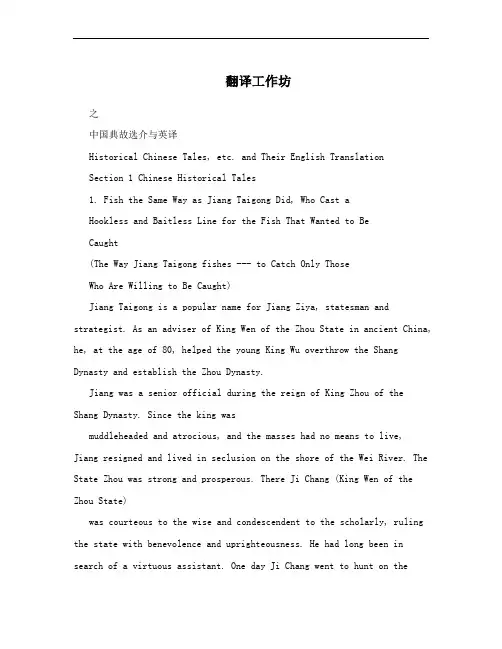
翻译工作坊之中国典故选介与英译Historical Chinese Tales, etc. and Their English TranslationSection 1 Chinese Historical Tales1. Fish the Same Way as Jiang Taigong Did, Who Cast aHookless and Baitless Line for the Fish That Wanted to BeCaught(The Way Jiang Taigong fishes --- to Catch Only ThoseWho Are Willing to Be Caught)Jiang Taigong is a popular name for Jiang Ziya, statesman and strategist. As an adviser of King Wen of the Zhou State in ancient China, he, at the age of 80, helped the young King Wu overthrow the Shang Dynasty and establish the Zhou Dynasty.Jiang was a senior official during the reign of King Zhou of the Shang Dynasty. Since the king wasmuddleheaded and atrocious, and the masses had no means to live,Jiang resigned and lived in seclusion on the shore of the Wei River. The State Zhou was strong and prosperous. There Ji Chang (King Wen of the Zhou State)was courteous to the wise and condescendent to the scholarly, ruling the state with benevolence and uprighteousness. He had long been in search of a virtuous assistant. One day Ji Chang went to hunt on thenorthern shore of the Wei River. He saw an old man fishing by the shore who, oblivious of so many people passing by, continued to fish quietly. That was Jiang. It was said he was over 70 then. Ji Chang felt curiousso he stepped down from the chariot and walked to the old man, only to find the man‘s fishhook was not bent, impossible to get any fish. Realizing this man was not a common one, Ji Chang began to chat with him. He found this was the right man he was in quest of, so he said, ―Before he died, my grandfather had anticipated that Zhou would become prosperous when a sage came to us. You are the sage I‘ve been looking for. My grandfather had long expected your arrival!‖ So he calle d him Taigong. He returned with Taigong, sharing his carriage with him, and treated him as his mentor(导师;顾问;国师). Taigong assisted Ji Chang.The Western Zhou became more flourishing, so the people of other states came over and pledged allegiance one after another. After Ji Chang passed away, his son JiFa (King Wu) succeeded to the throne. With Jiang Shang‘s assistance, Ji Fa met the sovereigns of the other states in Mengjin and then they together sent an army to crusade against Zhou. As a result, King Zhou of the Shang Dynasty burned himself to death. After the downfall of the Shang Dynasty, Ji Fa established the Zhou Dynasty. Known as King Wu in history, he honored his father with the posthumous title of King Wen.**Chinese Version:1.姜太公钓鱼民间有句俗话,叫做“姜太公钓鱼——愿者上钩”。

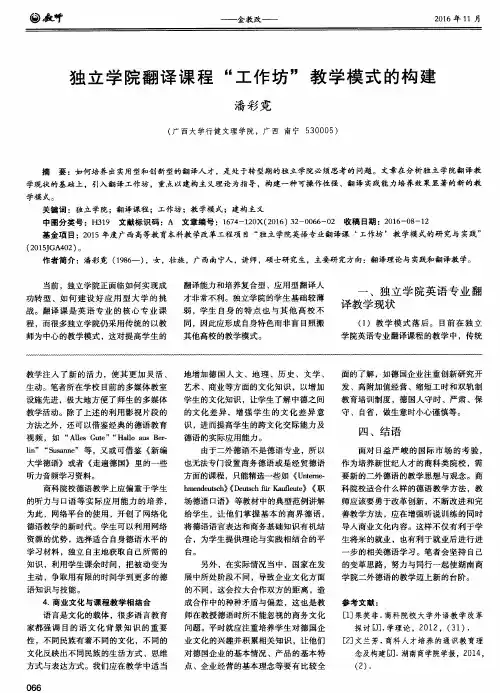
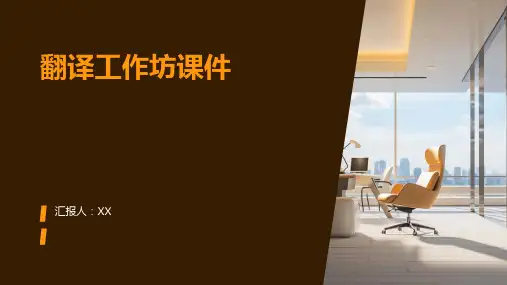
翻译工作坊教学模式与思维能力的培养
翻译工作坊是一种以实践为基础的翻译教育方法,通过让学生在真实的翻译项目中掌
握翻译技巧和经验,来培养翻译能力和思维能力。
翻译工作坊的教学模式主要包括三个环节:讲解、实践和反思。
在讲解环节中,教师会向学生介绍翻译原则、技巧和经验,以及相关的语言学知识和
文化背景。
教师还会根据学生的水平和需求,设计不同难度的翻译任务,帮助学生提高翻
译水平。
在实践环节中,学生会根据教师布置的翻译任务,进行实际的翻译练习。
学生需要在
限定的时间内完成任务,并提交翻译作品。
教师会对学生的翻译作品进行评价和指导,帮
助学生找到自己的翻译问题和优势,引导学生进行自我反思和提高。
在反思环节中,学生会对自己的翻译作品进行深入的分析和评价,找出自己的问题并
思考如何改进。
学生还会与教师和同学进行讨论,分享自己的翻译心得和经验,学习其他
同学的翻译方法和技巧。
通过这种教学模式,翻译工作坊可以有效地培养学生的翻译能力和思维能力。
首先,
通过实践中积累和总结的经验和技巧,学生可以逐渐提高自己的翻译能力,更加熟练地运
用语言和文化知识。
其次,通过反思和讨论,学生可以认识到自己的翻译问题和思维误区,以及其他同学的翻译方法和思考方式,从而不断完善自己的思维能力和解决问题能力。
One characteristic of Western culture is the emphasis on individual contribution. Perhaps there may be some historical or religious reasons, but the mainstay(主要的依靠) of Western culture is the individual. This trait is manifested in the making of individual heroes in Western culture and creativity. The individual’s contributions are placed above collective effort. The advantage of this is that it can spur people on to greater heights. The flaw is that it results in self-centered individualism, which affects creativity indirectly.西方文化的一个特点是强调个人的贡献,或许这里有些许历史与宗教方面的原因。
以个人为主的西方传统风格,(演变到今日)表现在西方文化和创造发明中往往是制造个人英雄,并将其个人贡献置于集体之上。
其好处是激发人的进取心,弊端是导致以个人为中心,间接影响创新。
Up to some level, creativity requires the coordination of all sides. Eastern culture can play a positive role in this. The traditional Eastern education system stresses building a solid foundation, and then builds up the basic knowledge step by step. However, Eastern tradition places too much emphasis on foundations. The insistence on rote learning affects the initiative to make bold hypotheses and argumentation about new situations and new problems.创新,到达一定程度之后需要各方面的配合。